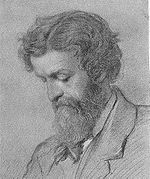- Charles Thomas Newton
-
Charles Thomas Newton
Charles Thomas NewtonBorn 16 September 1816
Bredwardine , HerefordshireDied 28 November 1894 Nationality British Fields archaeology Sir Charles Thomas Newton (16 September 1816 – 28 November 1894) was a British archaeologist. He was made KCB in 1887.[1]
Newton was born at Bredwardine in Herefordshire, and educated at Shrewsbury School and Christ Church, Oxford. He entered the British Museum in 1840 as an assistant in the Antiquities Department. Antiquities, classical, Oriental and medieval, as well as ethnographical objects, were at the time included in one department, which had no classical archaeologist among its officers.
In 1852 Newton left the Museum to become vice-consul at Mytilene, with the object of exploring the coasts and islands of Asia Minor. Aided by funds supplied by Lord Stratford de Redcliffe, then British ambassador at Constantinople, he made in 1852 and 1855 important discoveries of inscriptions at the island of Kalymnos, off the coast of Caria; and in 1856-1857 achieved the great archaeological exploit of his life by the discovery of the remains of the mausoleum of Halicarnassus, one of the seven wonders of the ancient world. He was greatly assisted by Murdoch Smith, afterwards celebrated in connection with Persian telegraphs. The results were described by Newton in his History of Discoveries at Halicarnassus (1862–1863), written in conjunction with R. P. Pullan, and in his Travels and Discoveries in the Levant (1865). These works included particulars of other important discoveries, especially at Branchidae, where he disinterred the statues which had anciently lined the Sacred Way, and at Cnidos, where Pullan, acting under his direction, found the colossal lion now in the British Museum.
In 1855 Newton declined the regius professorship of Greek at Oxford. In 1860 he was made British consul at Rome, but had scarcely entered upon the post when an opportunity presented itself of reorganizing the amorphous department of antiquities at the British Museum, which was divided into three and ultimately four branches. The Greek and Roman section naturally fell to Newton, who returned as Keeper, and held the office until 1885, declining the offer of the principal librarianship made to him in 1878. The Mausoleum Room, to accommodate the treasures he had found in Asia Minor, was built under his supervision, but the most brilliant episode of his administration was the acquisition of the Blacas and Castellani gems and sculptures. The Farnese and Pourtals collections were also acquired by him. He took a leading part in the foundation of the Society for the Promotion of Hellenic Studies, the British School at Athens, and the Egypt Exploration Fund. He was Yates professor of classical archaeology at University College, London, from 1880 to 1888. His collected Essays on Art and Archaeology were published in 1886. When, on his retirement from the Museum, his bust by Boehm, now placed in one of the sculpture galleries, was presented to him as a testimonial, he desired the unexpended balance to be given to the school at Athens. After his retirement he was much occupied with the publication of the Greek inscriptions in the British Museum, but his health failed greatly in the latter years of his life. He died at Margate. He married in 1861 the daughter of his successor in the consulate at Rome, the painter Joseph Severn; she was Ann Mary Newton, herself a distinguished artist. She died in 1866.
References
- ^ "NEWTON, Sir CHARLES THOMAS". Dictionary of National Biography, Supplement, III: 224–225. 1901. http://books.google.com/books?id=B7nQAAAAMAAJ&pg=224.
 This article incorporates text from a publication now in the public domain: Chisholm, Hugh, ed (1911). Encyclopædia Britannica (11th ed.). Cambridge University Press.
This article incorporates text from a publication now in the public domain: Chisholm, Hugh, ed (1911). Encyclopædia Britannica (11th ed.). Cambridge University Press.
- Charles T. Newton, History of Discoveries at Halicarnassus(1863) Vol. II
- Charles T. Newton, Travels & Discoveries in the Levant (1865) Vol. II (reissued by Cambridge University Press, 2010. ISBN 9781108017442)
- Charles T Newton, Essays on Art and Archaeology (1886) Macmillan, London. (reissued by Cambridge University Press, 2010. ISBN 9781108017411)
Categories:- 1816 births
- 1894 deaths
- British archaeologists
- Employees of the British Museum
- Old Salopians
- Recipients of the Royal Gold Medal
Wikimedia Foundation. 2010.

